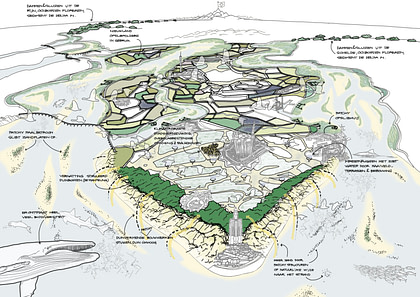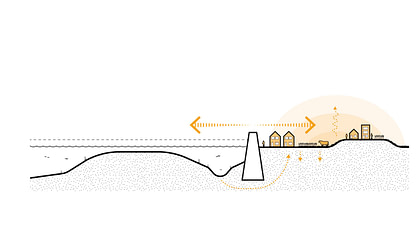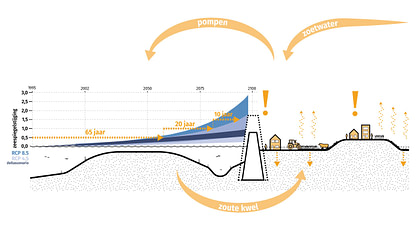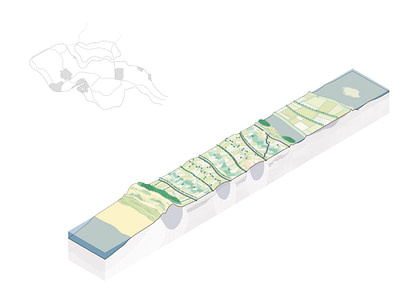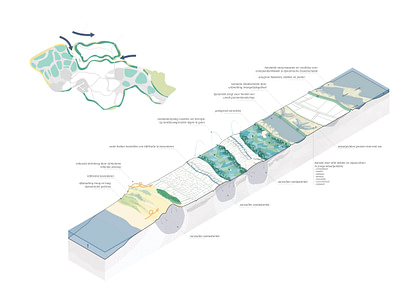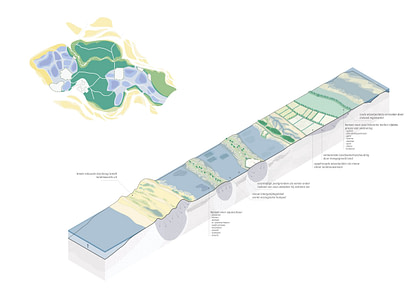

2023
An odyssey to new Zeeland
2023
An odyssey to new Zeeland
For centuries, the sea was connected to the land in Zeeland. This dynamic relationship resulted in a marine ecosystem where people, land and water shaped the landscape. In the last century, dams and dikes brought Zeeland safety from flooding. But the historical, economic and emotional bond between the people of Zeeland and the sea disappeared. At the same time, the area faces major challenges. The sea level is rising, the polders are sinking, the soil is becoming salinized, the freshwater supply is shrinking.
Zeeland
EO-Wijers stichting, Zuidwestelijke Delta, Provincie Zeeland
Ro&Ad architecten, Jim van Belzen, NIOZ, Buiting Advies, Solidarity University, Natuurverdubbelaars, Roosemalen & Savelkoul
150 000 ha
The key to this is system restore. In other words: moving with the natural forces of the delta system. This involves ending developments and investments that go against the system but instead kickstarting natural processes and utilizing these natural forces for everything we do: living, working, producing and recreating. Wind pushes sand up into dunes, rain saturates the soil, the tides and sediment allow the land to grow.

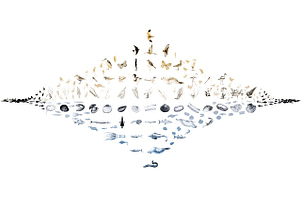
For this it is important to make optimal use of the delta’s growing capacity. Firstly, by allowing sediment into the delta. With moderate sea level rise, parts of Zeeland can grow along with a higher water level. Seagrass, cordgrass and mussels create ideal conditions for other species. These ‘biobuilders’ also retain sediment and thus help the land to grow. Secondly, by seeing the existing dike rings and polder structures as the framework for spatial interventions. We work with the conditions that were formed over the past centuries and propose to follow the path of reverse-engineering. The youngest polders are the first places where the dynamics of the delta return.
In order to ‘let go’ we need something to hold on to. Building a new future for Zeeland can only be done together. How can we involve the residents of Zeeland in this process of moving along with natural forces? We propose to start small and jointly experience that ‘using natural forces’ is indeed possible. This paves the way for transitions that lead to new realities and new landscapes.

The cycle consists of four adaptation steps. Depending on the necessity or circumstances, the next phase comes into effect.
Step 1. Preparing and strengthening.
The lowest polders – where most of the villages and towns are located – are protected. At critical locations double dikes and foreshore protection with salt marsh and mudflats will reinforce the sea barrier. This is the very beginning of system recovery. The most saline polders are used to retain fresh water, creating opportunities for wet crops and nature development.
Step 2. Strengthen and grow.
Natural dynamics return to the system. The Oosterscheldekering, the Philipsdam, the Zandkreekdam and the Veerse Dam are one by one being replaced by bridges. Sediment flows into the system and the natural exchange between salt and fresh water is restored. The logic of reverse engineering applies here: the youngest dam is the first to disappear, the youngest polders are the first to be opened up and start to gradually grow by sedimentation. A system of large ‘wisselpolders’ will be created within the existing dikes. When these polders have grown to the desired height, the dike ring is closed and first saline and then freshwater cultivation is possible. The ‘wisselpolders’, salt marshes and mudflats increase water safety. The creek ridges in the ‘Oudland’ polders are used to increase the underground freshwater supply. New forms of housing are appropriate for this step: houses on creek ridges, mudflat stilt houses in a patchy pattern, salt marsh and mud houses that stimulate sedimentation, and ‘stuifwoningen’ – the ultimate recreational homes in the dune area.
Step 3. Growing and salinizing
The ‘wisselpolder’ system produces growing land on the outside of the dikes that are first salt but later become freshwater environments. Although agricultural productivity has fallen for a while, farmers are regaining prospects for the future. Due to dune formation, the foredune moves inland – becoming wider and stronger. The dike rings and polder structures form a framework for the rotating system of growing ‘wisselpolders’. The cities and villages are protected by a ring of higher built neighborhoods. Floating houses will be built in the lowest areas.
Step 4. Salinization and evolution.
With 1.5 degrees of global warming, the lowest polders will come under the direct influence of the salt water. The landscape shows a reversal in this phase. The ‘Nieuwland’ polders, the new areas outside the dikes and the dynamic dune arch form the new Zeeland. Fresh water accumulates in this new land and nature-inclusive agriculture is the norm. The many transitions between fresh and salt offer opportunities for all kinds of crops and nature alike. Alternative living arrangements make it possible to live in harmony with the water.
